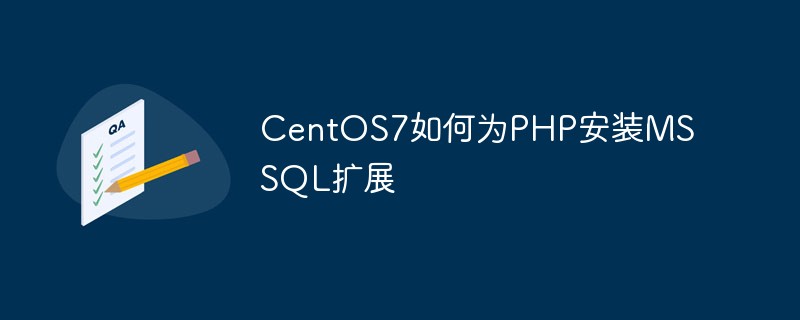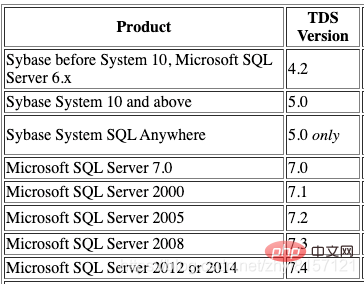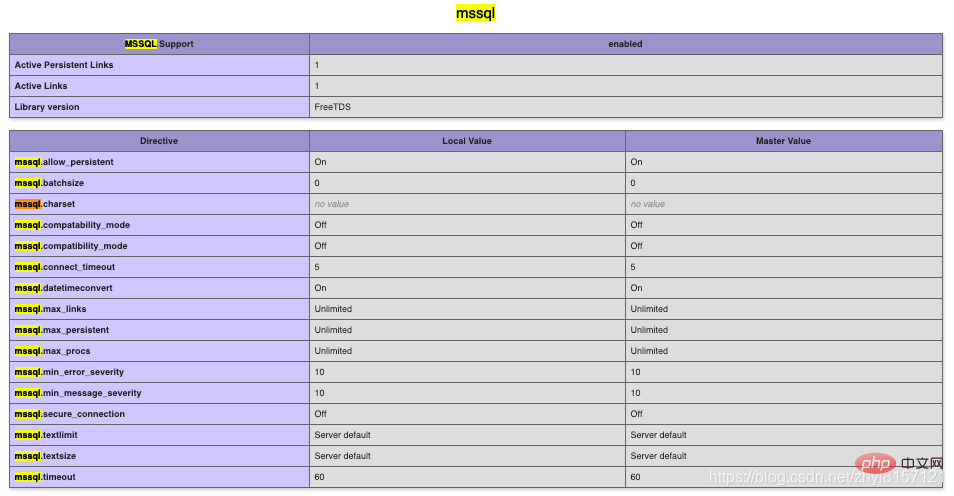How to install MSSQL extension for PHP in CentOS7
This article will introduce to you how to install MSSQL extension for PHP in CentOS7. It has certain reference value. Friends in need can refer to it. I hope it will be helpful to everyone.

1. Download freetds
and execute the following scripts in sequence:
cd /usr/local/src/ wget ftp://ftp.freetds.org/pub/freetds/stable/freetds-patched.tar.gz tar -zxvf freetds-patched.tar.gz
That is, enter / usr/local/src directory (I usually put the source code used for compilation here), download the source code of freetds, and then unzip it.
2. Install freetds
Execute the following scripts in sequence:
cd freetds-1.2/ ./configure --prefix=/usr/local/freetds --with-tdsver=7.4 --enable-msdblib make && make install
Pay attention to the above freetds-1.2, according to your own Depending on the downloaded version of freetds, this may be different. Anyway, just enter the folder you got after unzipping it. Then --with-tdsver=7.4 Here, you can choose flexibly according to the different versions of SqlServer. You can refer to the picture below to choose by yourself. I am using SqlServer 2012 , so the 7.4 version selected:

The content selected for the above version comes from the official document of freetds, the document address: https: //www.freetds.org/userguide/ChoosingTdsProtocol.html
3. Configurationfreetds
Execute the following commands in sequence to initialize the freetds configuration:
echo "/usr/local/freetds/lib/" > /etc/ld.so.conf.d/freetds.conf ldconfig
Other configurations are not required. There are some tutorials on the Internet about configuring the connection information of MSSQL in freetds.conf. In fact, it is not necessary. You can configure it when calling, that is, configure it in the PHP code. This is so flexible.
4. Testfreetds
Execute the following command to view the freetds version:
# /usr/local/freetds/bin/tsql -C
Compile-time settings (established with the "configure" script)
Version: freetds v1.2
freetds.conf directory: /usr/local/freetds/etc
MS db-lib source compatibility: yes
Sybase binary compatibility: no
Thread safety: yes
iconv library: yes
TDS version: 7.4
iODBC: no
unixodbc: no
SSPI "trusted" logins: no
Kerberos: no
OpenSSL: yes
GnuTLS: no
MARS: yesExecute the following command to testfreetds Connection:
# /usr/local/freetds/bin/tsql -H example.com -p 1433 -U username -P password locale is "en_US.UTF-8" locale charset is "UTF-8" using default charset "UTF-8" 1> select @@version 2> go Microsoft SQL Server 2012 - 11.0.2100.60 (X64) Feb 10 2012 19:39:15 Copyright (c) Microsoft Corporation Standard Edition (64-bit) on Windows NT 6.2 <X64> (Build 9200: ) (Hypervisor) (1 row affected)
where example.com is the host address of MSSQL, username and password are the username and password of MSSQL respectively.
5. Download PHP-5.6.40 Source code
Execute the following scripts in sequence:
cd /usr/local/src/ wget https://www.php.net/distributions/php-5.6.40.tar.gz tar -zxvf php-5.6.40.tar.gz
is the same as downloading freetds above , we won’t go into details here.
6. Install PHP-5.6.40-MSSQL Extension
Execute the following scripts in sequence:
cd php-5.6.40/ext/mssql/ /www/server/php/56/bin/phpize ./configure --with-php-config=/www/server/php/56/bin/php-config --with-mssql=/usr/local/freetds/ make && make install
/www/server above /php/56/bin/ path, because the installation path of php used in Pagoda is this, so the path is written like this. You can adjust it according to your own situation.
Get output similar to the following, indicating that the extension installation is complete:
... Build complete. Don't forget to run 'make test'. Installing shared extensions: /www/server/php/56/lib/php/extensions/no-debug-non-zts-20131226/
7. Modify php.ini
You can modify it as you like here , I directly used the Pagoda front-end to modify it, without using the command line. Add the following lines in php.ini:
[mssql] extension=mssql.so
Save the changes after completing them, and then restart the php service.
Check phpinfo, you can see that the mssql extension has been enabled.

Done.
Recommended learning: php video tutorial
The above is the detailed content of How to install MSSQL extension for PHP in CentOS7. For more information, please follow other related articles on the PHP Chinese website!

Hot AI Tools

Undresser.AI Undress
AI-powered app for creating realistic nude photos

AI Clothes Remover
Online AI tool for removing clothes from photos.

Undress AI Tool
Undress images for free

Clothoff.io
AI clothes remover

Video Face Swap
Swap faces in any video effortlessly with our completely free AI face swap tool!

Hot Article

Hot Tools

Notepad++7.3.1
Easy-to-use and free code editor

SublimeText3 Chinese version
Chinese version, very easy to use

Zend Studio 13.0.1
Powerful PHP integrated development environment

Dreamweaver CS6
Visual web development tools

SublimeText3 Mac version
God-level code editing software (SublimeText3)

Hot Topics
 1666
1666
 14
14
 1425
1425
 52
52
 1327
1327
 25
25
 1273
1273
 29
29
 1252
1252
 24
24
 PHP and Python: Comparing Two Popular Programming Languages
Apr 14, 2025 am 12:13 AM
PHP and Python: Comparing Two Popular Programming Languages
Apr 14, 2025 am 12:13 AM
PHP and Python each have their own advantages, and choose according to project requirements. 1.PHP is suitable for web development, especially for rapid development and maintenance of websites. 2. Python is suitable for data science, machine learning and artificial intelligence, with concise syntax and suitable for beginners.
 PHP: A Key Language for Web Development
Apr 13, 2025 am 12:08 AM
PHP: A Key Language for Web Development
Apr 13, 2025 am 12:08 AM
PHP is a scripting language widely used on the server side, especially suitable for web development. 1.PHP can embed HTML, process HTTP requests and responses, and supports a variety of databases. 2.PHP is used to generate dynamic web content, process form data, access databases, etc., with strong community support and open source resources. 3. PHP is an interpreted language, and the execution process includes lexical analysis, grammatical analysis, compilation and execution. 4.PHP can be combined with MySQL for advanced applications such as user registration systems. 5. When debugging PHP, you can use functions such as error_reporting() and var_dump(). 6. Optimize PHP code to use caching mechanisms, optimize database queries and use built-in functions. 7
 PHP in Action: Real-World Examples and Applications
Apr 14, 2025 am 12:19 AM
PHP in Action: Real-World Examples and Applications
Apr 14, 2025 am 12:19 AM
PHP is widely used in e-commerce, content management systems and API development. 1) E-commerce: used for shopping cart function and payment processing. 2) Content management system: used for dynamic content generation and user management. 3) API development: used for RESTful API development and API security. Through performance optimization and best practices, the efficiency and maintainability of PHP applications are improved.
 PHP vs. Python: Understanding the Differences
Apr 11, 2025 am 12:15 AM
PHP vs. Python: Understanding the Differences
Apr 11, 2025 am 12:15 AM
PHP and Python each have their own advantages, and the choice should be based on project requirements. 1.PHP is suitable for web development, with simple syntax and high execution efficiency. 2. Python is suitable for data science and machine learning, with concise syntax and rich libraries.
 The Enduring Relevance of PHP: Is It Still Alive?
Apr 14, 2025 am 12:12 AM
The Enduring Relevance of PHP: Is It Still Alive?
Apr 14, 2025 am 12:12 AM
PHP is still dynamic and still occupies an important position in the field of modern programming. 1) PHP's simplicity and powerful community support make it widely used in web development; 2) Its flexibility and stability make it outstanding in handling web forms, database operations and file processing; 3) PHP is constantly evolving and optimizing, suitable for beginners and experienced developers.
 PHP and Python: Code Examples and Comparison
Apr 15, 2025 am 12:07 AM
PHP and Python: Code Examples and Comparison
Apr 15, 2025 am 12:07 AM
PHP and Python have their own advantages and disadvantages, and the choice depends on project needs and personal preferences. 1.PHP is suitable for rapid development and maintenance of large-scale web applications. 2. Python dominates the field of data science and machine learning.
 PHP vs. Other Languages: A Comparison
Apr 13, 2025 am 12:19 AM
PHP vs. Other Languages: A Comparison
Apr 13, 2025 am 12:19 AM
PHP is suitable for web development, especially in rapid development and processing dynamic content, but is not good at data science and enterprise-level applications. Compared with Python, PHP has more advantages in web development, but is not as good as Python in the field of data science; compared with Java, PHP performs worse in enterprise-level applications, but is more flexible in web development; compared with JavaScript, PHP is more concise in back-end development, but is not as good as JavaScript in front-end development.
 PHP and Python: Different Paradigms Explained
Apr 18, 2025 am 12:26 AM
PHP and Python: Different Paradigms Explained
Apr 18, 2025 am 12:26 AM
PHP is mainly procedural programming, but also supports object-oriented programming (OOP); Python supports a variety of paradigms, including OOP, functional and procedural programming. PHP is suitable for web development, and Python is suitable for a variety of applications such as data analysis and machine learning.




